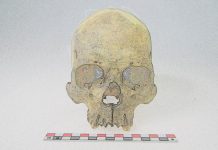
Researchers have unearthed three ancient Roman lead ingots in Northern Córdoba, shedding light on the region’s pivotal role in metal production and exportation during the Roman era.
The ingots, found at the site of Los Escoriales de Doña Rama in Belmez, are believed to date back to the first century A.D. and demonstrate the area’s historical importance as a major center for smelting.
Each ingot measures about 45 centimeters in length and weighs between 24 and 32 kilograms.
Their triangular shape, similar to a Toblerone bar, was likely designed to optimize storage and transportation.
Two of the ingots bear the inscription “S S”, identifying them as products of the Societas Sisaponensis, a mining company from La Bienvenida, but headquartered in Córdoba.
This marking not only links the ingots to their producer but also suggests they were intended for export, packed onto ships along with other goods.
The significance of these findings is underscored by the location of their discovery.
Unlike most lead ingots of this type, which are typically found at the bottom of the Mediterranean Sea from shipwrecks, these were found on land, close to where they were produced.
This rare occurrence offers a unique glimpse into the local production and distribution networks of the time.
The ingots were originally unearthed during the twentieth century while work was being conducted on the Maghreb-Europe gas pipeline and have since been kept in the Belmez Museum and private collections.
Recent studies published in the Journal of Roman Archaeology have brought to light the ingots’ origins and chemical makeup, confirming they were made from ore mined in the Fuente Obejuna-Azuaga district, a noted mining area that includes the Doña Rama site.
Further analysis by a multidisciplinary team revealed that the ingots had been desilvered, a process that separates silver from lead, indicating a high level of metallurgical expertise.
This discovery aligns with historical records that highlight ancient Córdoba, particularly the central Sierra Morena area, as a hub for mining and metal production.
Antonio Monterroso Checa, a researcher at UCO, emphasized the significance of these findings, stating, “This information demonstrates that, in antiquity, these northern regions of Córdoba boasted major metallurgical networks of great commercial and economic importance in the Mediterranean.”
He also noted that the Doña Rama site likely hosted a mining town complete with a foundry, a processing area, and possibly a fortress, though much remains to be studied about the area.
This discovery not only highlights the advanced industrial skills of the region but also its crucial role in the Mediterranean trade during the Roman period.
The lead ingots serve as a testament to the sophisticated network of production and distribution that existed thousands of years ago.



